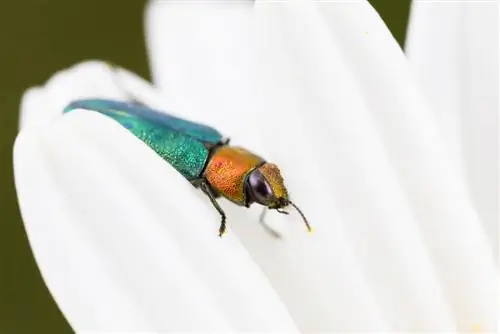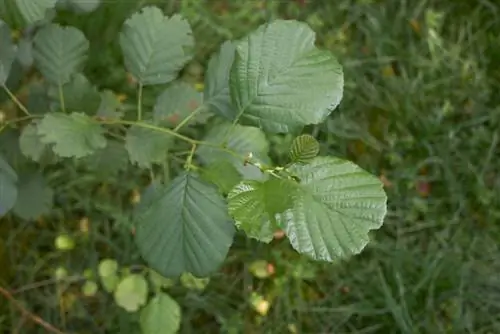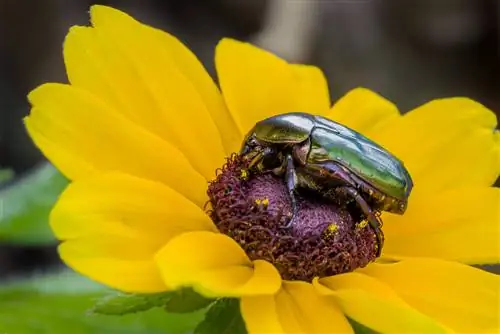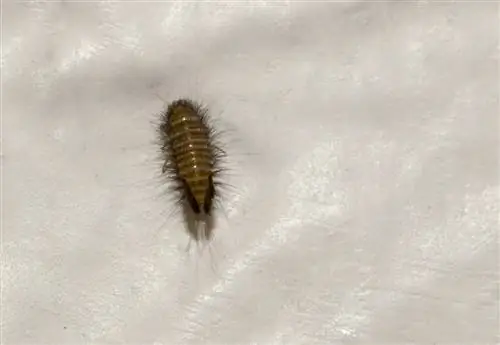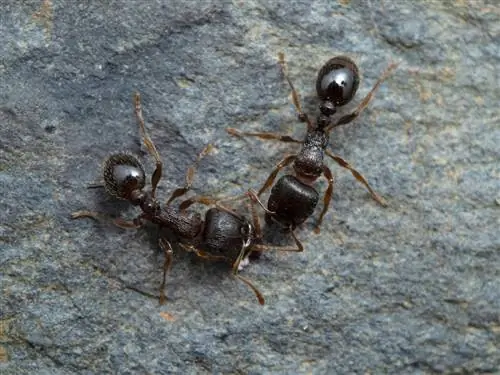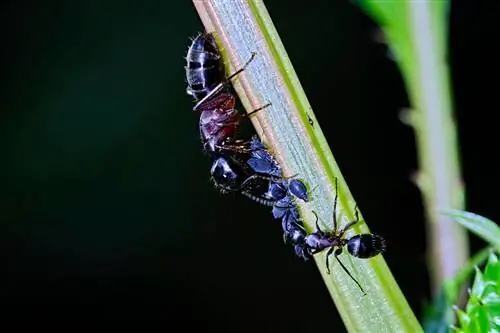- Author admin [email protected].
- Public 2023-12-16 16:46.
- Last modified 2025-06-01 06:02.
When a green beetle sparkles in the bushes, busy hobby gardeners pause in amazement. What type of beetle might be visiting the garden? This guide explains how to identify large and small beetles by their appearance.
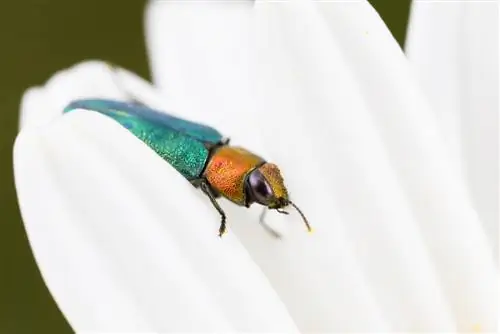
What types of green beetles are there in Germany?
In Germany there are various species of green beetles, including large ones such as the golden rose beetle, golden ground beetle, pupa robber, green longhorn beetle and emerald speed runner, and small ones such as the green shield beetle, silky weevil, shiny jewel beetle, green-blue case beetle and mint leaf beetle. They are harmless and not poisonous.
- The most common large green beetle in Germany is the 15-20 mm large gold rose beetle, also called the green knight beetle. Other large green beetle species include the golden ground beetle, large pupal robber, green longhorned beetle and emerald speed runner.
- Small green beetles are between 5 and 11 mm in size and go by the names green shield beetle, silky weevil, shiny jewel beetle, green-blue case beetle and mint leaf beetle.
- A green beetle in the apartment is not a real beetle, but the green stink bug. The broad oval insect can smell bad, but is harmless and not poisonous.
Big green beetle - which one is it?
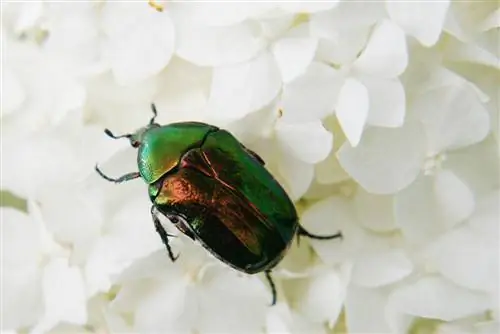
The gold rose beetle has a golden shimmer
In the species-rich microcosm of native beetles, the dividing line between large and small is 10 millimeters. From this size onwards, green beetles cause a sensation when they boast of their metallic, iridescent color nuances. Once you know the most important facts, you can easily identify large green beetles by their appearance. The following table gives an overview of 5 common beetle species in Germany with a penchant for green:
| Big green beetle | Gold Rose Beetle | Gold Ground Beetle | Doll Robbers | Green Longhorn Beetle | fast runner |
|---|---|---|---|---|---|
| Length | 15-20mm | 18-32mm | 20-30 mm | 8-15mm | 11-15mm |
| color | metallic gold-green | green-gold shimmering | blue-green metallic | metallic green-shiny | glossy black-green |
| Body shape | spherical | elongated | wide-oval | long drawn | elongated |
| Top wing | with white dots | red-yellow border | reddish longitudinally grooved | ribbed, gaping | flat ribbed |
| Special feature | wide flat longitudinal ribs | orange-red legs | blue-purple neck shield | long antennae | orange legs/feelers |
| Botanical name | Cetonia aurata | Carabus auratus | Calosoma sycophanta | Oedemera nobilis | Harpalus smaragdinus |
| Middle name | Green Knight Beetle | Goldsmith | Great Doll Robber | Blue-green leg beetle | Emerald Fast Runner |
Informative details about the appearance and habitat of our five large green beetles are provided in the following meaningful short portraits.
Golden rose beetle (Cetonia aurata)
The most prominent large green beetle in Germany is the almost 2 cm long golden rose beetle. Its sturdy shell shimmers metallic green-gold, sometimes reddish to violet or blue-black. In addition to the two flat longitudinal ribs and white dots on the cover wings, a green knight beetle can be identified by white, narrow transverse bands in the rear third. If a careless rose beetle falls on its back, a reddish-golden underside can be admired.
- Where to find: Shrubs, preferably roses, hawthorns and elderberries, in forests, meadows and gardens
- When to find: April to September
You can admire golden rose chafers in action in the following video:

Golden Ground Beetle (Carabus auratus)
One of Germany's most beautiful natural jewels impresses as a shiny green beetle with a golden shimmer. The red-yellow edged cover wings are each characterized by three wide, green-gold longitudinal ribs. The strikingly long antennae, the first four limbs of which are colored red, are helpful for identifying the golden ground beetle.
- Where to find: fields, meadows, forest edges, rarely in the garden
- When to find: April to September
Pupal robber (Calosoma sycophanta)
As a blue-green beetle up to 3 cm long, the pupa predator is hard to miss. Its trademark is its metallic blue neck shield, picturesquely decorated with a shimmering green edge. The gem belongs to the ground beetle family, but also likes to fly and hunt for caterpillars and other prey.
- Where to find: forests, parks, large gardens
- When to find: May to September
Green Longhorned Beetle (Oedemera nobilis)

The green longhorned beetle is easily distinguishable from other green beetles with its long, narrow body and long antennae
With a length of 8 to 15 mm, the longhorned beetle cannot decide whether it wants to be a large or small green beetle. Given its other attributes, it is easy for laypeople to accurately identify the blue-green thigh beetle. Epically long antennae are striking. Its metallic green wing covers become narrower towards the abdomen. Significantly thickened hind legs are noticeable in males.
- Where to find: meadows, shrubs, bushes
- When to find: April to July
Emerald speed runner (Harpalus smaragdinus)
Emerald-green wing coverts and agile orange legs characterize the fast runner from the ground beetle family. The orange-brown feelers and pliers are tastefully colour-coordinated. As a complementary decoration, the shiny, black-brown collar has an orange border.
- Where to find: biotopes, open land, garden
- When to find: April to September
Excursus
Green insect with a beetle look
If a green beetle stinks badly in your apartment, you are faced with a bug in a green summer dress. The green stink bug (Palomena prasina) has a 14 mm large, broadly oval body, boasts long antennae and a conspicuous proboscis. From spring to summer, the beetle-like insect appears in a bright green robe with black dots. In autumn the bug adapts to the season with a subtle red-brown color. When temperatures drop, the green stink bug leaves the forest in search of cozy winter quarters. The harmless insect sometimes gets lost in apartments. Now it's time to stay calm, because when danger threatens, stink bugs live up to their name because they emit a foul-smelling secretion. Let the uninvited guests crawl onto a piece of paper to get them outside and you will be spared the dreaded stink bomb effect.
Little green beetle - which one is it?
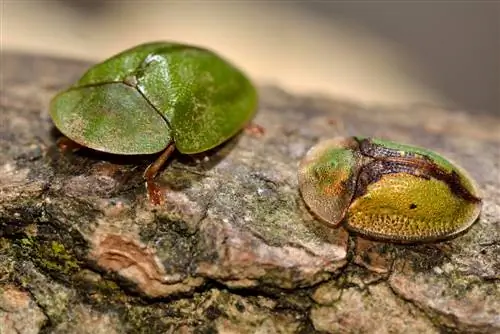
The green shield beetle is often difficult to see with the naked eye
You have to look closely if you want to address a little green beetle by its real name. With a body size below the threshold of 10 millimeters, a bright green shiny beetle is clearly ahead in terms of attention. The following 5 beetle dwarves speak German and are easy to identify by their appearance:
| Little green beetle | Green Shield Beetle | Silky Weevil | Shiny jewel beetle | Green-blue Fallen Beetle | Mint Leaf Beetle |
|---|---|---|---|---|---|
| Length | 7-10mm | 5-7mm | 5-8mm | 6-8mm | 7-11mm |
| color | grass green | green shiny | blue-green | gold-green-blue metallic | green-gold shiny |
| Body shape | flat-oval | oval-elongated | elongated | cylindrical | plump |
| Top wing | yellowish flat border | dark longitudinal furrows | flat, densely dotted | finely granulated | distinctive dotted |
| Special feature | short, brown legs | long trunk | red-gold head | shiny metallic feelers | red-yellow, 2nd antennal segment |
| Botanical name | Cassida viridis | Polydrusus formosus | Anthaxia nitidula | Cryptocephalus sericeus | Chrysolina herbacea |
| Middle name | Shield Beetle | Green Weevil | Flower Beetle | Silky Fallen Beetle | Shiny Mint Leaf Beetle |
The following short portraits are peppered with further information about the appearance of small green beetles in Germany.
Green shield beetle (Cassida viridis)
Flat, like a flounder, grass-green cover wings without a shimmering sheen. A green shield beetle has unmistakably chosen a subtle appearance. In this way, the small beetle makes itself almost invisible when it nibbles on the leaves of mint plants, such as hollowtooth and wolfstrap.
- Where to find: wet meadows, swampy biotopes, lake and pond shores
- When to find: May to October
Silky weevil (Polydrusus formosus)
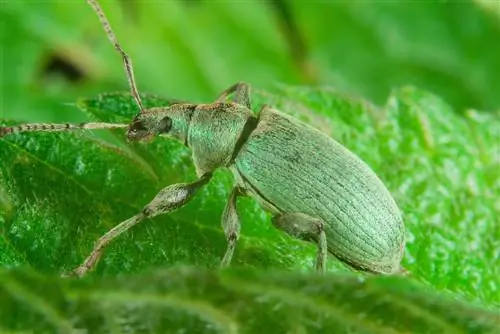
The Silky Weevil has a silky shiny body
From the weevil family, the silky weevil made it onto our list because it decided against the usual black-brown coloring. The black weevil spices up its black shell with shiny green scales, orange, green powdered legs and brown-yellow antennae.
- Where to find: deciduous forest, shrubs, in the garden
- When to find: May to August
Shiny jewel beetle (Anthaxia nitidula)
His name is not an empty promise, because a shiny jewel beetle is truly a feast for the eyes. The entire body of males sparkles metallic green. Females combine a red-gold head for a picturesque appearance. A look at the pronotum dispels any remaining doubts about the type of beetle because it is significantly wider than it is long.
- Where to find: orchards, forest edges, gardens
- When to find: May to June
Green-blue Fallen Beetle (Cryptocephalus sericeus)
The native fall beetle flirts with iridescent metallic colors in green, gold, gold-green, blue to violet. The elytra are more coarsely dotted than the pronotum. The S-shaped curved edges of the shimmering pronotum provide important identification assistance. Furthermore, the cylindrical body is not completely covered by cover wings.
- Where to find: meadows, sunny slopes, rare in the garden
- When to find: May to July/August
Mint leaf beetle (Chrysolina herbacea)
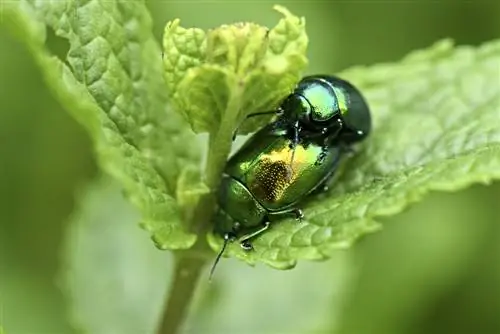
If there are shiny beetles on mint, they are definitely mint leaf beetles
If an iridescent gold-green beetle crawls over mint species, it should not be difficult to identify the species. Densely dotted cover wings and a finely granulated pronotum reveal whether it is actually the mint leaf beetle. In addition, the lateral edge of an elytra is only visible up to the middle of the body.
- Where to find: in the garden
- When to find: May to September
Tip
For nature-loving hobby gardeners, it is a reason to be happy when fat grubs colonize the compost heap. Beetle beauties such as the golden rose beetle or rhinoceros beetle are happy to set up their nursery here. The powerful larvae with their C-shaped bodies work hard to produce humus by feeding on and decomposing plant residues.
Notifiable and invasive - Japanese beetle (Popillia japonica)

Left: The tufts of hair are the main characteristics of the Japanese beetle, Right: When in danger, the beetle stretches its legs away
The Japanese beetle is an invasive species that is introduced to us via imports. The Japanese beetle feeds on approximately 300 different plants, including fruit trees and grape vines. Special features are the white tufts of hair and the body size of 8 to 12 mm. If you have spotted a Japanese beetle, you should report your discovery to the reporting office in your federal state.
- Where to find: in the garden
- When to find: May to September
Frequently asked questions
Which large green beetle is similar to a cockchafer?
Rose beetles and cockchafers belong to the family of scarab beetles (Scarabaeidae). The botanical relationship is reflected in a similar appearance in terms of size and body shape. This is where the similarities end. Rose beetles shine with a gold-green sparkle shell. In contrast, cockchafers with inconspicuous, brown cover wings maintain a life beyond the shimmering beetle splendor.
Can rose beetles bite?
Rose beetles are leaf beetles and prefer to feed on sweet plant juices, delicate pollen and velvety petals. The mouthpart is already too weakly developed to bite into the strong leaves of roses. For this reason, the magnificent beetles do not even attempt to bite into human skin.
Should you control large green beetles on roses?
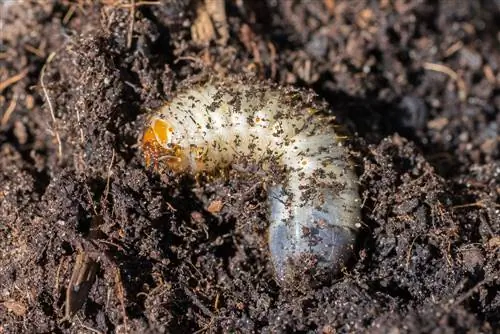
Rose beetle larvae cause great damage to the garden
Adult rose beetles sip nectar, feast on pollen and nibble a little on flower petals. The shiny gold-green beetles do not cause any significant damage. Rather, this is the acceptable price for an important contribution to the ecosystem as a flower pollinator and humus producer. Give rose beetles a warm welcome in the garden instead of fighting the protected insects.
Tip
The Nature Conservation Association of Germany (NABU) has a free app available for all insect lovers to identify common native beetles and other insects. Automatic photo recognition serves as an identification aid. Informative species portraits invite the whole family to take a stroll through our diverse world of insects.

